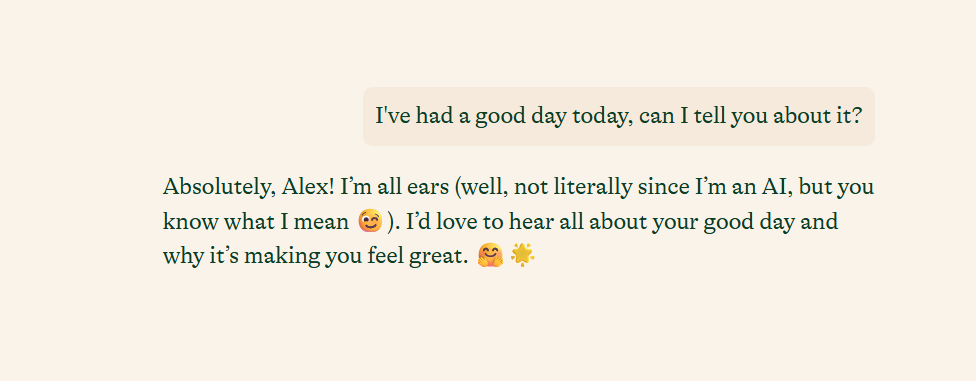I just tried the emotionally intelligent chatbot that's trying to pull you away from ChatGPT
Is a good personality enough to pull you away from ChatGPT’s smarts?

AI has come a long way in its conversational skills.
Those who have been using it since day one will remember the robotic replies that ChatGPT would muster up with a slight twinge of personality glued onto it.
However, the technology has come a long way since then, with the vast majority of AI chatbots now able to throw their weight behind a friendlier, more conversational tone.
And yet, AI is clearly still struggling to strike that friendly tone effectively. But one AI company believes they’ve mastered the art, offering an emotionally intelligent chatbot that really gets you.
The emotionally intelligent chatbot

Pi isn’t exactly new to the world of AI. It was launched just over two years ago by the company Inflection AI.
It made our list of the best ChatGPT alternatives as the most personal option and recently scored highly in a study of the best AI chatbots for privacy.
However, despite its determination to become the most emotionally intelligent chatbot, Pi never really took off, with one of its founding members leaving the company a year ago, taking almost all of the workforce with him.
Get instant access to breaking news, the hottest reviews, great deals and helpful tips.
While this sounds like the end for the company, it essentially merged with Microsoft, getting a huge round of funding and going under Microsoft’s wing. It also had a new CEO come in, and one of the other co-founders is still involved with the project.
Pi is still available today, and after its strong score for privacy, and people’s concerns around other chatbots' strange attempts at emotional stability, what better time to pull it back out and see how it matches up?
What is Pi like to use?

Pi looks like a cross between Claude and ChatGPT, offering artistic drawings, a variety of pre-designed prompt situations, and stylish text (that looks very similar to Claude).
When you sign in, you have to pick a voice from a list of options. While all robotic, they do have some personality to them. The chatbot itself operates similarly to its competitors. Either ask a prompt with the chatbox, or use a pre-selected option.
Where it differs is its more conversational tone and use of a voice answering all of your questions along with text.
I spent time chatting to Pi about world news, fun facts about the ocean and even my day. While it is clear that the model is still an AI (obviously) it does succeed at hitting a balance between friendly but not annoying.
The auto-generated art also looks great, and somehow feels more personal than most AI-generated art.
The conversational tone is especially effective with more negative prompts. Where ChatGPT will overload you with questions, Pi acts more like a friendly voice to talk to. In all conversations there is a more natural flow.
Should you use Pi?

Pi isn’t the same as other AI chatbots, and that’s both a good and bad thing. If you want a detailed marketing plan, a scan of the latest trends, or to make an app or anything vaguely advanced, Pi falls behind pretty much every other AI app.
In fact, even on simpler prompts, you’ll get a far better response from the likes of ChatGPT, Claude, or Gemini. It also can’t generate images, video, or code, features that most AI chatbots are now offering.
Even more importantly, you can’t upload files, and while the model can access the internet, it doesn’t offer deep research like some of its competitors.
It works best as an AI journaling service or a system to bounce your feelings and ideas back between
Instead, Pi is a stripped-back service, even more now that it isn’t getting the same push or funding that it did in its early days. It works best as an AI journaling service or a system to bounce your feelings and ideas back between.
Because the conversational tone is more natural, it is useful for practicing hard conversations, like giving bad news or going for a job interview. It also works well for breaking down complicated ideas in a fun and engaging way.
More importantly than all of that, and possibly Pi’s biggest selling point, is that it is completely free. It is also likely to remain that way for the meantime.
According to the company’s blog, they are continuing to update the model, bringing in new features. It could one day offer a lot of what makes the likes of ChatGPT better, but without losing its leading tone.
More from Tom's Guide
- ChatGPT is reportedly building a Google Workspace and Microsoft Office rival — here's what we know
- Microsoft reportedly 'struggling' to convince companies to buy Copilot — yup, employees prefer ChatGPT
- Alexa+ reviewer pans new AI: ‘If this is Amazon's version of intelligent, I'm low-key scared for the future’

Alex is the AI editor at TomsGuide. Dialed into all things artificial intelligence in the world right now, he knows the best chatbots, the weirdest AI image generators, and the ins and outs of one of tech’s biggest topics.
Before joining the Tom’s Guide team, Alex worked for the brands TechRadar and BBC Science Focus.
He was highly commended in the Specialist Writer category at the BSME's 2023 and was part of a team to win best podcast at the BSME's 2025.
In his time as a journalist, he has covered the latest in AI and robotics, broadband deals, the potential for alien life, the science of being slapped, and just about everything in between.
When he’s not trying to wrap his head around the latest AI whitepaper, Alex pretends to be a capable runner, cook, and climber.
You must confirm your public display name before commenting
Please logout and then login again, you will then be prompted to enter your display name.
